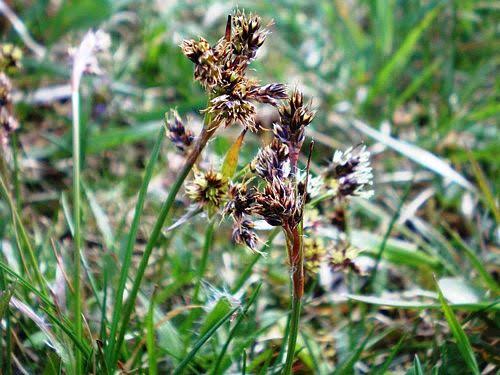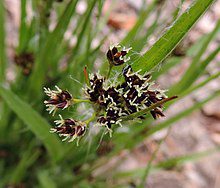Woodrush (Luzula spp.) is a group of plants that grow in many places around the world. These plants are part of the larger family known as Juncaceae. Woodrushes are often found in forests, meadows, and even in some wet areas.
One interesting thing about Woodrush is its appearance. The leaves are usually long and narrow, and they form tufts or clumps. The stems can grow upright, reaching varying heights depending on the specific species. The flowers of Woodrush are not flashy; instead, they are small and inconspicuous, arranged in clusters or spikes.
One of the notable features of Woodrush is its adaptability. Different species of Woodrush can be found in diverse habitats, from woodlands to grasslands. Some even thrive in areas with poor soil conditions. This adaptability makes Woodrush a resilient and versatile plant in various ecosystems.
Woodrushes also play a role in the environment. They contribute to the overall biodiversity of ecosystems by providing habitat and food for various insects and small animals. Additionally, their presence can influence soil structure and nutrient cycling.
In terms of human use, Woodrushes are not typically cultivated for economic purposes. However, some species may have traditional uses in folk medicine or as materials for weaving in certain cultures. Despite not being extensively used by humans, Woodrushes hold ecological significance in maintaining the balance of natural habitats.
In addition, Woodrush (Luzula spp.) is a diverse group of plants that can be found in different environments worldwide. Their adaptability, simple yet unique appearance, and ecological roles make them an interesting component of various ecosystems. While not widely utilized by humans, these plants contribute to the overall biodiversity and functioning of natural habitats.
Read Also: Environmental Factors Affecting Feed Consumption in Fishes
How To Grow Woodrush (Luzula spp.)

To grow Woodrush (Luzula spp.), follow these steps:
1. Select the Right Location: Choose a location with the appropriate light conditions. Woodrushes generally prefer partial to full shade, although some species can tolerate sun.
2. Prepare Well-Drained Soil: Ensure the soil is well-drained as Woodrushes prefer moist but not waterlogged conditions. Add organic matter like compost to improve soil structure.
3. Planting Depth: When planting Woodrush seeds or transplants, follow the recommended planting depth specific to the species. Generally, planting at a shallow depth is advised.
4. Watering: Keep the soil consistently moist, especially during the establishment phase. Water regularly, but avoid waterlogged conditions.
5. Mulching: Mulch around the base of Woodrush plants to retain moisture, suppress weeds, and provide a more favorable environment for their growth.
6. Fertilization: Woodrushes are not heavy feeders, but you can apply a balanced, slow-release fertilizer in spring to support their growth.
7. Pruning: While Woodrushes don’t require extensive pruning, removing dead or damaged foliage can help maintain a tidy appearance. Trim as needed to control the size.
8. Division: If the Woodrush clumps become too large or crowded, consider dividing them. This can be done in early spring or fall.
9. Pest and Disease Management: Keep an eye out for pests or diseases, though Woodrushes are generally hardy. Treat any issues promptly to maintain plant health.
10. Winter Care: Some Woodrush species are evergreen, while others may die back in winter. Adjust your care routine based on the specific characteristics of the Woodrush species you are growing.
By following these general guidelines, you can cultivate and nurture Woodrush (Luzula spp.) in your garden or landscape.
How To Care For Woodrush (Luzula spp.)
You can Care for Woodrush (Luzula spp.) by:
1. Watering Adequately: Keep the soil consistently moist, especially during dry periods. While they can tolerate some drought, consistent moisture promotes healthy growth.
2. Light Conditions: Place Woodrushes in locations with appropriate light conditions. Most species prefer partial to full shade, but some may tolerate sun to varying degrees.
3. Soil Maintenance: Ensure well-drained soil by incorporating organic matter like compost. This helps in retaining moisture without causing waterlogging.
4. Mulching: Apply mulch around the base of Woodrush plants to conserve moisture, suppress weeds, and maintain a more favorable environment.
5. Fertilization: While Woodrushes are not heavy feeders, a balanced, slow-release fertilizer in spring can support their growth. Avoid excessive fertilization.
6. Pruning: Trim dead or damaged foliage to maintain a tidy appearance. Some species may benefit from occasional pruning to control size and shape.
7. Division: If the clumps become too large or overcrowded, consider dividing them. This can be done in early spring or fall to rejuvenate the plants.
8. Pest and Disease Monitoring: Keep an eye out for pests or diseases, though Woodrushes are generally hardy. Address any issues promptly to maintain plant health.
9. Winter Considerations: Adjust care based on the Woodrush species. Some are evergreen, while others may die back in winter. Adapt your care routine accordingly.
By following these care practices, you can help Woodrush (Luzula spp.) thrive and contribute to the beauty of your garden or landscape.
Read Also: How to Farm and Care for Goldstripe Sardinella Fish (Sardinella gibbosa)
The Uses of Woodrush (Luzula spp.)

Uses of Woodrush (Luzula spp.) include:
1. Ecological Role: Woodrushes contribute to biodiversity by providing habitat and food for various insects and small animals.
2. Erosion Control: Some species of Woodrush can help prevent soil erosion due to their root structure, making them beneficial in stabilizing soil.
3. Natural Aesthetics: Woodrushes add a simple yet unique aesthetic to gardens, meadows, and woodland areas with their tufted or clumped growth.
4. Traditional Uses: In certain cultures, specific species of Woodrush may have traditional uses in folk medicine or as materials for weaving.
5. Adaptability: Woodrushes showcase adaptability, growing in diverse habitats ranging from woodlands to grasslands and even in areas with poor soil conditions.
Wildlife Habitat: Woodrushes provide shelter and nesting sites for various small creatures, contributing to the overall biodiversity of ecosystems.
6. Soil Improvement: The presence of Woodrushes can influence soil structure and nutrient cycling, enhancing the overall health of the soil in their growing areas.
7. Low-Maintenance Landscaping: Due to their hardiness and adaptability, Woodrushes can be a low-maintenance landscaping option, requiring less attention than some other ornamental plants.
8. Educational Purposes: Woodrushes offer educational opportunities, allowing individuals to study and appreciate the diversity of plant life and their ecological interactions.
9. Conservation: Some species of Woodrush may be of interest for conservation efforts, especially if they are native to a particular region or considered at risk.
Woodrush (Luzula spp.) serves multiple purposes, ranging from ecological contributions to cultural significance, making them valuable components of various landscapes and ecosystems.
While not extensively used for economic purposes, Woodrushes play crucial ecological roles and have cultural significance in some regions.
Frequently Asked Questions (FAQs)
Q: What are Woodrushes (Luzula spp.)?
A: Woodrushes are a group of plants belonging to the Juncaceae family, known for their tufted or clumped growth. They can be found in diverse habitats worldwide.
Q: Where do Woodrushes typically grow?
A: Woodrushes thrive in various environments, including woodlands, meadows, and grasslands. They exhibit adaptability, growing in both shaded and sunny locations.
Q: How do I care for Woodrush plants?
A: Ensure well-drained soil, provide adequate moisture, and choose an appropriate light condition (partial to full shade). Regular pruning and occasional division may be needed.
Q: Are Woodrushes suitable for low-maintenance landscaping?
A: Yes, many Woodrush species are hardy and adaptable, making them a good choice for low-maintenance landscaping projects.
Q: What is the ecological role of Woodrushes?
A: Woodrushes contribute to biodiversity by providing habitat and food for insects and small animals. Some species also help prevent soil erosion.
Q: Can Woodrushes be used for traditional purposes?
A: In some cultures, specific species of Woodrush may have traditional uses in folk medicine or as materials for weaving.
Q: Are Woodrushes invasive?
A: Generally, Woodrushes are not considered invasive. However, specific species’ growth characteristics should be considered when planting in certain areas.
Q: When is the best time to divide Woodrush clumps?
A: Woodrushes can be divided in early spring or fall to rejuvenate the plants and manage their size.
Q: Do Woodrushes attract wildlife?
A: Yes, Woodrushes provide shelter and nesting sites, attracting various small creatures and contributing to wildlife habitat.
Q: Are there any conservation efforts related to Woodrushes?
A: Some species of Woodrush may be of interest for conservation efforts, especially if they are native to a particular region or considered at risk.
Q: Can Woodrushes tolerate dry conditions?
A: While Woodrushes prefer moist soil, some species can tolerate periods of drought. However, consistent moisture is generally beneficial for their optimal growth.
Q: Do Woodrushes require special fertilization?
A: Woodrushes are not heavy feeders, but applying a balanced, slow-release fertilizer in spring can support their growth. Avoid excessive fertilization, as it may not be necessary.
Q: How do I address pest and disease issues with Woodrushes?
A: Monitor for pests or diseases and treat any issues promptly. Woodrushes are generally hardy, but addressing problems early helps maintain their overall health.
Q: Are there specific uses of Woodrushes in landscaping?
A: Woodrushes can be used in landscaping to add a simple yet unique aesthetic. Their adaptability and low-maintenance nature make them suitable for various garden designs.
Q: Can Woodrushes be grown in containers?
A: While Woodrushes are typically planted in the ground, certain species may adapt to container gardening. Ensure well-draining soil and provide appropriate light conditions.
Q: Do all Woodrush species have similar appearances?
A: Woodrush species can vary in appearance, but they often share characteristics like long, narrow leaves and tufted or clumped growth. Specific features depend on the species.
Q: Are there any toxic properties associated with Woodrushes?
A: Woodrushes are not known to be toxic to humans. However, it’s essential to identify the specific species to rule out any potential concerns.
Q: How long do Woodrush plants typically live?
A: The lifespan of Woodrush plants can vary, but with proper care, they can persist for several years, contributing to the landscape over an extended period.
Q: Can Woodrushes be used for erosion control in landscaping projects?
A: Yes, certain species of Woodrush can be beneficial for erosion control due to their root structures, helping stabilize soil in landscaping projects.
